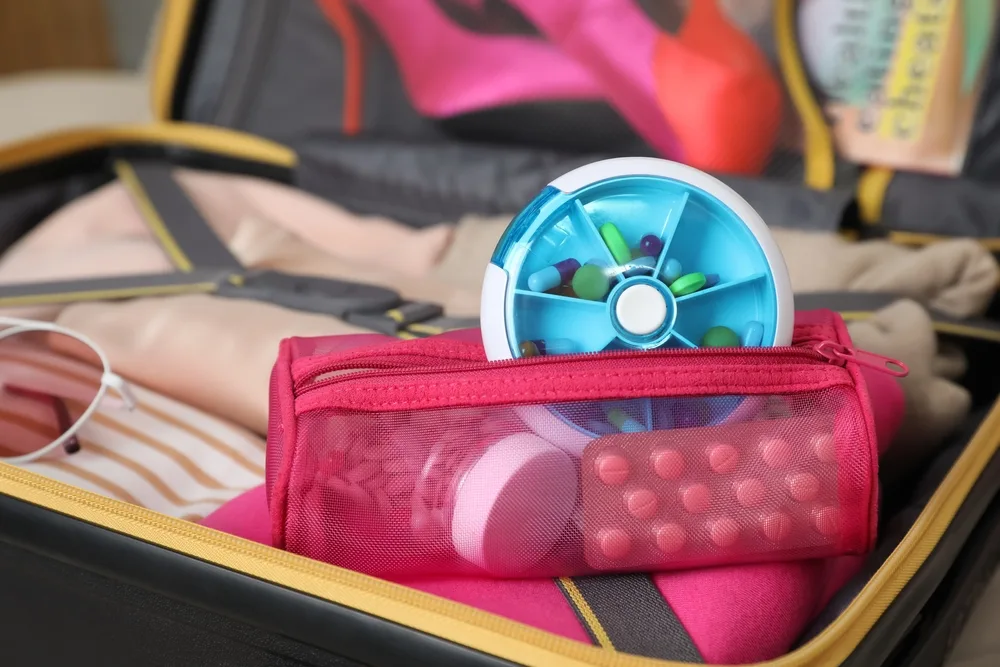How to manage medication when flying

Travelling should be exciting, not stressful, especially when you’re bringing medication along for the ride. Whether you live with a chronic condition or just need a few prescription items, it’s completely possible to fly smoothly with your medication – it just takes a bit of forward planning.
In this guide, we’ll cover everything you need to know about taking medication on a plane. From hand luggage tips to prescription rules and airport security advice, we’ve got helpful tips to make flying with medication easier.
8 Ways to make flying with medication simpler
Flying with medication doesn’t need to be complicated; it just takes a bit of know-how. These simple tips will help you keep your medication looked after while you’re away.
1. Pack medication in your hand luggage
Your medication should always go in your carry-on bag, and never in your checked suitcase. That’s because baggage can go missing, flights can be delayed, and cabin conditions can affect temperature-sensitive meds.
Here’s what to include in your hand luggage:
- Enough medication for your trip – plus extras, in case of delays
- Original packaging, with the pharmacy label intact
- A copy of your prescription (paper or digital)
- A doctor’s letter for any controlled drugs or injectable medicines
- Any medical devices, like insulin pens or inhalers
Keep everything in a clear, resealable plastic bag if you’re carrying liquids or gels – even if they’re medication. That includes eye drops, creams, or liquid antibiotics.
The HSE recommends bringing a list of your medications, including their generic names and what they’re for. This is especially useful if you lose anything or need help abroad.
2. Check airline and destination rules before you fly
Rules around travelling with medication can vary between countries and even between airlines. Before you pack, it’s important to check two key things:
1. Airline regulations
Each airline will have a medical assistance page outlining what you can bring onboard. Most are happy with basic prescription meds in your hand luggage, but may ask for supporting documents for liquid medications over 100ml or sharp objects like syringes or EpiPens.
2. Destination laws
Some countries have stricter laws around controlled or psychotropic substances. For example, codeine is banned or restricted in places like Japan and the United Arab Emirates. Ireland’s Department of Foreign Affairs recommends checking with the embassy of the country you’re visiting to make sure your meds are allowed.
The Irish Department of Health offers guidance on travelling with prescribed narcotics or psychotropic medicines.
3. Keep medication in its original packaging
It might seem handy to transfer tablets into a pill box or combine different medications into one container. But when you’re travelling, this could slow you down at airport security, or even lead to your medication being confiscated.
Always keep your medication:
- In its original blister packs or bottles
- Clearly labelled with your name and dosage
- Alongside the dispensing pharmacy’s label
This makes it clear to airport staff and customs that what you’re carrying is legally prescribed to you. It’s also helpful if you’re stopped for a bag check or need to replace medication abroad.
4. Bring a doctor’s letter – especially for injectables
If your medication includes anything unusual – like liquids over 100ml, medical syringes, or controlled drugs – a signed doctor’s letter can help you get through security more smoothly.
Your GP should include:
- Your name and date of birth
- Details of your medication (name, dosage, why it’s needed)
- Any medical devices (e.g. insulin pens, nebulisers, blood glucose monitors)
- Their own contact details
If your airline requires it, this letter may need to be dated within a certain number of weeks before travel, so check their rules early. Citizens Information has practical details on how prescriptions work when travelling.
5. Time zone? Time your doses
Flying across time zones can throw off your medication schedule. For short trips within Europe, you might only be adjusting by an hour or two. But if you’re heading further afield, like the US or Australia, planning your dosage times becomes more important.
If your medication needs to be taken at specific times (like insulin or heart meds), speak to your doctor or pharmacist before flying. They can help you adjust your routine gradually or give clear instructions for when to take your next dose after landing.
Using a simple alarm or reminder app can help – and if in doubt, stick to your departure time zone until you get settled.
6. Keep medication cool (if needed)
Some medications, like insulin or biologics, need to be stored between 2°C and 8°C. If that applies to you, don’t worry – there are a few easy ways to keep meds at the right temperature during your flight.
You can use:
- A medical-grade cool bag
- Ice packs or gel packs (check they’re airport security-approved)
- A Frio wallet – these handy evaporative cases are TSA- and airport-approved
Let your airline know in advance if you need a fridge onboard (some long-haul flights offer this). Also, ask for your medication to be labelled “keep refrigerated” by your pharmacy.
7. Be ready at security – and speak up if needed
Airport security can be stressful, but being prepared makes it much easier. When you reach security screening:
- Take out any liquids or medical devices and place them in a tray
- Mention you’re carrying medication if asked
- Show your doctor’s letter or prescription if needed
If you have a hidden condition or need discreet support (like extra time or help lifting a bag), you can request assistance in advance or use the sunflower lanyard system for hidden disabilities at most major Irish airports.
8. Travel insurance that covers your condition
Finally, make sure your travel insurance actually covers the medication you rely on and the condition it supports. That includes:
- Declaring any pre-existing conditions when you buy your policy
- Listing your medication if asked during the medical screening process
- Choosing a provider that understands how your condition affects your trip
A good policy won’t just help with lost meds. It’ll also support you if your condition flares up abroad, or if your trip is disrupted because of it.
A little planning goes a long way
Flying with medication doesn’t have to be a hassle. With a little preparation – and the right cover in place – you can focus on enjoying your trip, not stressing about your health.
Travelling smart means planning ahead. And if things change at the last minute? That’s what your travel insurance is for.
Get a quick travel insurance quote
Affordable travel insurance for all your needs
Discover the World
Stay up to date with the latest travel tips and advice

The ultimate Portugal travel guide for 2026

7 Best Christmas markets in Europe
